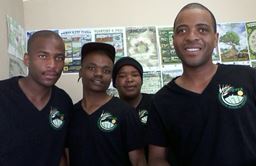
Our Eastern Cape Holistic Pilot
Here we started thinking, and doing, systemically...(2011 - 2016)
In 2011 the Departments of Science and Technology (DST) and Basic Education (DBE) jointly identified a need for a “technology-intensive, holistic, systemic and multi-layered intervention that could be tested in a limited rural educational space.” The Nciba School Circuit at Cofimvaba in the Chris Hani District, classified as one of the rural “distressed districts,” was selected for a range of interventions to:
- Inform rural education development policy, specifically with regards to large scale technology application (“crowding-in of technology”);
- Demonstrate and validate a rural innovation and socio-economic development systems approach; and to
- Provide an initial prototype for scaling up of integrated rural development programmes.

The Arthur Mfebe Senior Secondary School, its feeder schools’ personnel and governing bodies demonstrated strong ownership and initiative. The DST and its National System of Innovation (NSI) partners thus focused the “rural innovation and socio-economic development” interventions in this area - central to the dysfunctional Qamata irrigation scheme. As innovation became a key element across all project activities, the focus was shifted to Technology for Rural Innovation and Education Development (Tech4RIED).
A Living Lab methodology was used to ensure a participatory response to the different and complex stakeholder-needs. This approach caters for user-driven, open innovation within complex real-life, rural and urban settings. It was strengthened by the Outcomes Mapping Monitoring and Evaluation approach that informed both our intentional design and the adjustments made during various phases of the project. We’ve learned important lessons at various levels during this time.
At the institutional level it became clear that the already burdened school system battled to fulfil the role of sole catalyst for rural innovation. This prompted the initiation of a dedicated local catalyst grouping of young people while still retaining the education system as support and resource environment for innovation.
We also learned that smaller and quicker project adjustments create a more conducive environment for innovation. In the process it also became abundantly clear that the tangible benefits of such a systemic-change-approach need to have regular, beneficial effects to ensure the sustained engagement of participants. Moreover, it also must provide the impetus and rewards for mind-set and behavioural adaptations to uphold the momentum of social change.
Here it was reiterated again, that technology stands in service of humans, not the other way around. This can look deceptively obvious but in practice requires a major mind-shift in the NSI towards human centred, participatory design and development, also implying a bias for ‘bottom-up’ approaches. Failing to consider and understand the lifestyles, passions, aspirations and motivations of the people affected by change and technology, seems to be one of the biggest contributors to the breakdown of technology intensive (and other) development approaches - and seemingly, vice versa.

The insights gained from this project can make valuable contributions towards the revitalisation of rural (and urban) innovation systems. Our strategy here was to use and employ rural agricultural incubators and youth networks to design and test techno-socio-& economic interventions with the potential to become drivers and enablers of rural advancement. This project hence provides innovative, new and tested models for development in distressed districts and regions.

More information is available from this case study.





